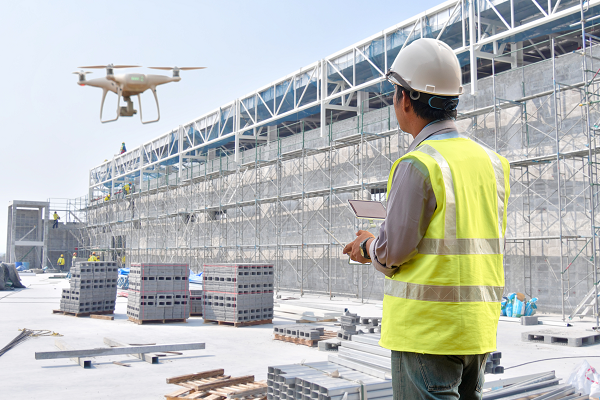If you work in the drone industry, you probably know what a “commercial” drone is. It’s a drone used for business, a drone used to make money.
However,  those looking to find jobs in the drone industry or business leaders seeking to integrate drones into their operations may not fully understand the differences between a commercial drone, a recreational drone, and other types of uncrewed vehicles. Also, they may not know the many rules, regulations, and restrictions that guide commercial uncrewed aerial vehicle (UAV) use.
those looking to find jobs in the drone industry or business leaders seeking to integrate drones into their operations may not fully understand the differences between a commercial drone, a recreational drone, and other types of uncrewed vehicles. Also, they may not know the many rules, regulations, and restrictions that guide commercial uncrewed aerial vehicle (UAV) use.
So, to help drone industry newcomers—and provide a kind of “refresher course” to those already in the field—Commercial UAV News offers this look at “What is a ‘Commercial’ Drone?”
A Basic Definition
A stated above, a commercial drone is an uncrewed vehicle that is put to use for business. That means builders who use drones to inspect construction sites are commercial drone operators. Professional photographers who fix cameras to drones to take wedding photos or images for newspapers and magazines are using drones commercially. Farmers who use drones to spray their crops are commercial drone operators. Retail stores that deliver packages with uncrewed systems are engaged in commercial drone activities.
According to the Federal Aviation Administration (FAA), 338,614 of the 872,248 drones registered in the US are registered as commercial drones. The agency projects that the size of the commercial drone fleet in the US could jump to as much as 858,000 by 2026.
FAA Guidelines/Pilot Certification
The FAA has established guidelines to spell out the differences between the many types of uncrewed vehicles, including drones for recreation and racing, drones for public safety operations, advanced air mobility (AAM) aircraft, and commercial drones.
In simple terms, the FAA considers an aircraft to be a commercial drone if it is less than 55 pounds and intended for business applications following the FAA’s Small UAS Rule, generally referred to as “Part 107.” Under Part 107, commercial drone pilots are required to obtain a Remote Pilot Certificate – Part 107 license from the FAA.
To receive the required Remote Pilot Certificate – Part 107 license, individuals must:
- Be at least 16 years old.
- Be able to understand, read, write, and speak English.
- Be mentally and physically able to operate a UAV safely.
- Pass the initial aeronautical knowledge exam.
Operations Over People
The FAA’s definitions for different aircraft and rules for drone pilots were developed to ensure safety. Because drones are a relatively new form of commercial aircraft, new regulations were needed to reduce risks to people and property on the ground and other aircraft in the air.
To this end, the FAA instituted rules that govern where, when, and how commercial drones can fly. Under the agency’s “Operations Over People” rules, commercial UAV pilots can fly at night, and they can fly over people and moving vehicles without a waiver under Part 107. However, airspace authorization is required for night operations.
FAA rules also stipulate that commercial drones (and recreational drones) must stay under 400 feet above the ground in uncontrolled airspace. FAA permission is required before commercial drone operators can fly in this space.
Also, commercial drone pilots—just like recreational drone pilots—must stay away from restricted areas such as airports and stadiums, and they must steer clear of places where emergency operations are taking place.
Beyond Visual Line of Sight (BVLOS)
A significant issue facing commercial drone operations concerns flights beyond visual line of sight, commonly known as “BVLOS.” For many operations to be effective and profitable, they must be able to fly drones past the point where they can be seen by operators. Such operations include drone inspections of long stretches of power lines, deliveries of packages, food items, and medical supplies, and many public safety operations, such as search and rescue operations in remote areas.
For these applications, companies and organizations can request a BVLOS waiver from the FAA. Waivers have enabled many commercial drone operators to expand and improve their operations. For example, Southern Company, one of the largest electrical utilities in the US, has received waivers that allow it to perform a wide variety of transmission, damage assessment, and power generation missions. Recently, the FAA granted a waiver to Matternet, which will allow the drone delivery firm to greatly expand its package delivery operations.
Although many companies and organizations have applied for and received BVLOS waivers from the FAA in recent years, commercial drone industry leaders, along with some public officials, are pushing for regulatory changes and faster approval times. Last year, the FAA’s Beyond Visual Line of Sight Aviation Rulemaking Committee (BVLOS ARC) issued recommendations that would help companies “scale safely” as they expand operations beyond visual line of sight. Picking up on this work, members of Congress have pushed for a streamlined BVLOS approval process and other steps to bolster commercial UAV operations.
Remote ID
To better integrate drones into the national airspace and increase overall safety, the FAA has established rules around UAS Remote Identification or “remote ID.” A kind of “digital license plate,” remote ID enables a drone in operation to provide its location and identification information to other parties.
The FAA instituted remote ID rules in 2021. Under these rules, drone manufacturers must begin building drones that are remote ID compliant this year. By the fall, operators will be required to have remote ID enabled vehicles. These changes are bound to have a profound impact on existing and potential commercial drone operations.
Counter-UAS Systems
The rules and regulations discussed above are designed to make the airways safe for recreational and commercial drone operations. But inevitably, there are those who do not follow the rules, those that skirt the law. These are operators who fly too high, too fast, carry illegal cargo, or operate near airports and public events. Their actions not only endanger lives and property, they harm legitimate commercial drone operations and the industry as a whole. Fortunately, many companies and public agencies are working to develop effective “counter-UAS” strategies.
For example, WhiteFox Defense, a leader in counter-drone and airspace security technologies, is collaborating with the FAA on its testing and evaluation program for UAS detection and counter-UAS systems. Also, the Biden Administration put forth the “The Domestic Counter-Unmanned Aircraft Systems National Action Plan” in 2022. The plan seeks to create “new ground rules for the expanding uses of UAS and improve our defenses against the exploitation of UAS for inappropriate or dangerous purposes.”
These and many other efforts should improve safety in the skies and benefit commercial drone operators who operate in compliance with the law.
Getting Started in the Commercial Drone Industry
As the sections above show, it is important to understand the rules and comply with the law when getting involved in the commercial drone industry. But whether you are a business leader looking to integrate drone technology or an individual looking to break into the field, keep in mind that there is more to this business than rules and regulations.
Integrating drones into business operations requires investments in vehicles, software, personnel, and training. In many cases, new workflows must be created, and established practices must be altered to embrace a new way of doing business.
A recent Commercial UAV News report looks at the many “barriers” that hold back the UAV integration. In this report, experts look at the obstacles companies and organizations face when integrating uncrewed aerial systems technology in infrastructure and transportation, energy and utilities, construction, public safety and emergency services, precision agriculture, surveying and mapping, and mining. They also provide practical advice on overcoming those barriers.
Check it out and find the best ways to make your drone operations legal, safe, and profitable.















Comments